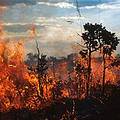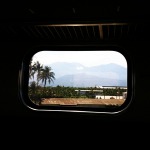 9月在巴西里約熱內盧Maciço da Pedra Branca森林的大火,造成了3公頃林地被焚毀,其主要原因為嚴重的乾旱。同一週內,就有另外170個起火點在里約熱內盧的森林和保育公園中發生。消防官員表示,這些火災大部分都是人們引發的,火災不斷發生,是因為人們缺乏對環境的責任感。
9月在巴西里約熱內盧Maciço da Pedra Branca森林的大火,造成了3公頃林地被焚毀,其主要原因為嚴重的乾旱。同一週內,就有另外170個起火點在里約熱內盧的森林和保育公園中發生。消防官員表示,這些火災大部分都是人們引發的,火災不斷發生,是因為人們缺乏對環境的責任感。
儘管沒有人員傷亡,但當地的動植物多樣性受到損害。不過,因為州立救火隊沒有提供足夠的資源,使得他們唯一的救火飛機故障時,另外兩架直升機必須盡最大的努力去滅火。
9月在Minas Gerais州,發現了超過400個起火點。又好比Parque do Rola Moça在2個月內幾乎燒毀了1000公頃的森林。
喜拉朵地區(Cerrado)的乾旱和20%的溼度,並未阻擋農夫在他們的土地上放火。在巴西利亞國家公園,有2.2公頃的土地發現失火,這些幾乎可以斷定是一個想用放火「處理」其土地的農夫做的。
在土地上放火可視為農民缺乏環境意識,但是放火可以增加農業土地。例如位在亞馬遜的Para州,Carajás森林有超過700公頃的土地被焚燒。
刻意放火清地的結果,在巴西,這些區域很常在失火。野生動植物,甚至牲畜,都成了灰燼。燒了好幾天的樹木,在風中猛烈燃燒著。在巴西廣大的區域,既沒有救火飛機,也沒有救火隊可以幫忙滅火。
 綿延21%巴西土地的喜拉朵區,是南美最大的森林平原,因為此地乾季長,讓許多適應乾燥和烈焰的植物和鳥類只在此區出現。大型的哺乳類像是巨食蟻獸、大犰狳、花豹和鬃狼等,仍存活在喜拉朵區,但卻必須和擴張快速的巴西農業競爭,尤其是大豆、玉米和畜牧業。
綿延21%巴西土地的喜拉朵區,是南美最大的森林平原,因為此地乾季長,讓許多適應乾燥和烈焰的植物和鳥類只在此區出現。大型的哺乳類像是巨食蟻獸、大犰狳、花豹和鬃狼等,仍存活在喜拉朵區,但卻必須和擴張快速的巴西農業競爭,尤其是大豆、玉米和畜牧業。
2003年,因為黃豆和牧牛的出口優勢,亞馬遜森林以火清除土地的結果,造成當年成為有史以來森林砍伐最嚴重的一年。
這種大型農業的操作手法,也被小農民學習起來,而且由於聯邦政府釋出亞馬遜流域的土地,有越來越多的小農民。這樣的放火燒地,也許可以解釋為何本區的森林砍伐率始終比1990年所清查的還要高。
Severe drought has been identified as the main cause of the fire that consumed three hectares of the Maciço da Pedra Branca forest in Rio de Janeiro state in one September day. In that same week, 170 other fire points were seen along the forests and conservation parks of the state of Rio de Janeiro. Fire officials said lack of environmental responsibility is to blame for these fires, many of them caused by human beings.
Local plant and animal biodiversity have been damaged, although no human injuries were reported despite the lack of resources from the state fire brigade that pressed their two helicopters to the maximum, as their one and only fireplane was broken.
In the state of Minas Gerais in September, more than 400 hundred points of fire were detected. For instance, almost 1,000 hectares were destroyed on less than two months at the Parque do Rola Moça.
But neither the drought nor the 20 percent humidity level in the Cerrado region have prevented farmers from setting fire to their properties. Fire was detected in a 2.2 hectare area at the National Park of Brasilia, almost certainly caused by a small farmer wanting to "clean" his property with fire.
Setting fire to the land could be seen as a lack of environmental awareness. But fires also can be used as a way to increase agricultural land. In the Amazon state of Para, for instance, more than 700 hectares burned in September in the Carajás forest.
As a result of the practice of deliberately setting fires for land-clearing, very common in Brazil, areas of the region are still burning. Wild animals, plants, even cattle, all become ashes. Trees burn for days, blazing away in the wild. No fire planes nor fire brigades are available to fight fires in vast regions of the country.
The Cerrado, stretching across 21 percent of Brazil, is the largest woodland-savanna in South America. With its long dry season, it supports drought and fire adapted plant species and bird species found nowhere else.
Large mammals such as the giant anteater, giant armadillo, jaguar and maned wolf still survive in the Cerrado but are competing with the rapid expansion of Brazil's agricultural frontier, especially soy, corn and livestock.
In 2003, the highest deforestation rates ever were recorded in the region as the result of land clearing of the Amazon forest in favor of soy and cattle exports.
The practices of large agricultural operations are then paralleled by small farmers, and there are more and more small farmers due to the increasing distribution of land in Amazonia by federal authorities. The subsequent burning may explain why deforestation rates in the region remain higher than those verified in the 1990s.
全文及圖片詳見ENS







